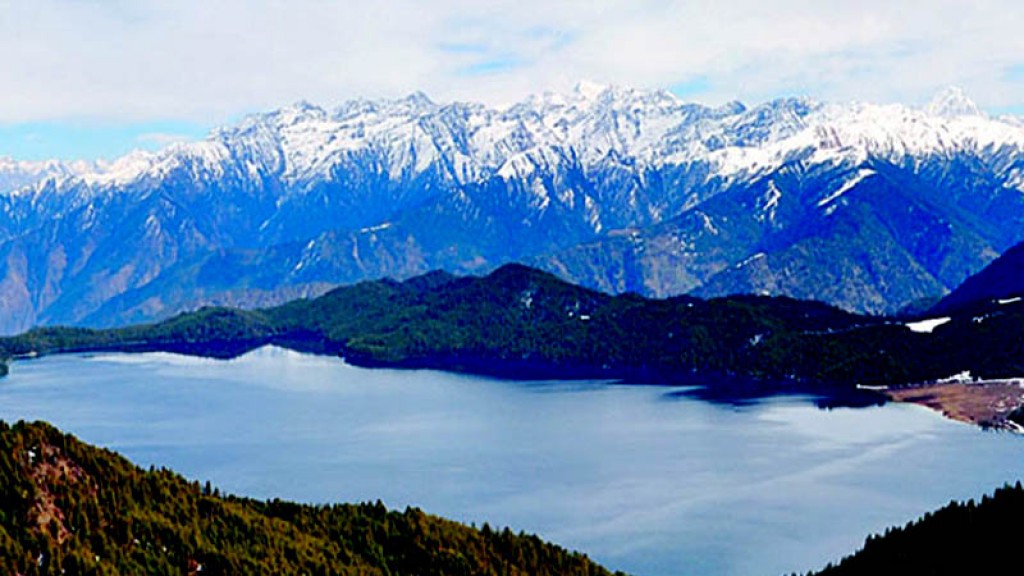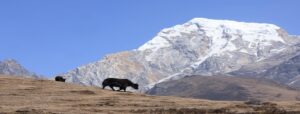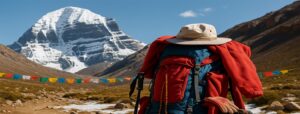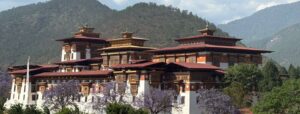Rara National Park includes one of the most fascinating lakes in Nepal, Rara Lake, which is frequently referred to as the “queen of lakes” to justify its beauty. The amazing Rara Lake Trek leads you to a hidden region of Karnali. The breathtakingly beautiful Rara Lake remains clean due to the limited number of visitors. One of the best parks in the world, Rara National Park, is reached by this undiscovered hike. Although it is the smallest national park in Nepal, it is home to Rara Lake, the largest lake in the nation, which spans 10.4 square kilometers and is located at a height of 3200 meters with a breathtaking terrain that sets it apart from the rest of the country.
Established in 1976, Rara National Park is a protected region located in Nepal’s Himalayas. Encompassing 106 km³ (41 sq mi) in the districts of Mugu and Jumla, it is the smallest national park in Nepal. The 2,990-meter-high Rara Lake is its main attraction. The park was established to preserve the distinct wildlife and plants of Nepal’s Humla-Jumla Region.
The park’s elevation varies from 2,800 meters (9,200 feet) to 4,039 meters (13,251 feet) at Chuchemara Peak, which is located on Rara Lake’s southern flank. With a surface area of 10.8 km2 (4.2 sq mi) and a maximum depth of 167 m (548 ft), the alpine freshwater lake is the largest in Nepal and is framed by the peaks of Ruma Kand and Malika Kand on the northern side. It is oval, measuring 3 km (1.9 mi) in width and 5 km (3.1 mi) in length. Nijar Khola is where it empties into the Mugu-Karnali River.
Climate and best time to visit
Summer here is very pleasant. Winter is, however, very cold. October and September through May are the ideal times of year to explore the park.
Also Read: Everything you need to know about Makalu Barun National Park
The park has Low temperatures and heavy snowfall up to one meter causing mountain passes to close from December through March. Warm weather prevails from April to June, although June to August is monsoon season.
What is Rara National- park famous for?
Rara Lake
The centerpiece of the park, Rara Lake, is the largest lake in Nepal. Its crystal-clear waters reflect the surrounding hills and snow-capped peaks, creating a breathtaking panorama. The lake changes colors throughout the day, making it a photographer’s paradise.

Rich Biodiversity
The park is home to a diverse range of flora and fauna. You can spot various species of mammals like red pandas, Himalayan black bears, musk deer, and more than 200 species of birds including the endangered Himalayan monal, kalij pheasant, and different migratory birds.
Scenic Landscapes
Rara National Park offers diverse landscapes, from lush forests of pine, spruce, and juniper to alpine meadows adorned with wildflowers during the summer months. The park’s terrain is a treat for trekkers and nature enthusiasts.
Cultural Experience
The park also provides a glimpse into the local Thakuri and Magar communities’ lifestyles. Visitors can interact with these ethnic groups, learn about their traditions, and experience their warm hospitality.
You may also like: Shey Phoksundo National Park
Trekking Trails
Trekking in Rara National Park is a popular activity. The park offers various trekking routes suitable for both beginners and seasoned trekkers. The trails pass through picturesque landscapes, allowing trekkers to soak in the natural beauty and serenity.
Remote and Pristine Environment
Due to its remote location, Rara National Park remains relatively untouched by mass tourism. This preserves its natural beauty and allows visitors to experience an unspoiled environment.
Wildlife Viewing
Wildlife enthusiasts can indulge in activities like bird watching and wildlife spotting. The park’s diverse ecosystems provide opportunities to spot rare and elusive species in their natural habitats.
Flora and Fauna
With 1,070 plant species known to exist there, Rara National Park is rich in both flora and fauna. Depending on the altitude, the vegetation is usually subalpine and temperate. The predominant vegetation found below 3,200 meters (10,500 feet) is blue pine (Pinus Excelsa), rhododendron (Rhododendron arboretum), west Himalayan spruce, black juniper, and Himalayan cypress. The vegetation transforms into a coniferous forest with a mixture of fir, spruce, and pine above 3,200 meters (10,500 feet).
The park is home to fifty-one species of mammals, including red pandas, jackals, Himalayan tahr, musk deer, Himalayan black bear, Indian leopard, otter, dhole, gray langur, and rhesus macaque.

241 bird species have been identified, 49 of which are found in wetlands. In the lake, coots are frequently spotted. In winter, common teal (Anas crecca), duck, red-crested pochards, great-crested and black-necked grebes, and common mergansers are common. The Himalayan snowcock, chukar partridge, Himalayan monal, kalij pheasant, and blood pheasant are among the other species that are frequently spotted.
Three indigenous species of snowtrout were discovered in Lake Rara in 1979 and were named as new species: the Nepalese snowtrout (Schizothorax Nepalensis), the Rara Snowtrout, and the Nepalese snowtrout.
Getting There
Despite the park’s lack of connection to the national road, there are two ways to get to Rara National Park: by air and by road. By road, the closest airports to the park are Talcha Airport in Mugu and Jumla Airport in Jumla. From Kathmandu, it takes four days to reach the park via the Karnali Highway, and from Nepalgunj, it takes up to three days to reach the lake via trekking. From Nepalgunj, there are two ways to reach the lake: one via the salt route to Humla and another via several trails through the Dolpo region.

Mugu and Kathmandu do not have direct aviation service. Only by traveling from Kathmandu to Nepalgunj or Surkhet can one arrive at Talcha via plane. Situated 4 km east of the lake, Talcha Airport serves Rara National Park primarily. Travel from Nepalgunj Airport to Talcha Airport and Jumla Airport is provided by Nepal Airlines, Sita Air, Summit Air, and Tara Air. Traversing Rara National Park on foot from Talcha Airport takes approximately three hours. In addition, a public bus arrives in Surkhet and departs toward Gamgadhi, the headquarters of Mugu.
Accommodation
Rara Lake Lodge: This lodge is located near Rara Lake and offers basic amenities such as rooms with beds, simple meals, and camping facilities. It’s one of the few options available within the park premises.
Homestays: Some local villagers near the park might offer homestay experiences, providing basic accommodation and an opportunity to immerse yourself in the local culture.
Camping: Camping is a popular option for visitors who prefer a closer connection to nature. While there are no designated campsites within the park, camping around Rara Lake or along trekking trails is a possibility. You might need to bring your camping gear or arrange for it locally.
Tented Camps: During peak tourist seasons, temporary tented camps may be set up by tour operators or trekking agencies. These camps offer more comfort than regular camping and may include meals and amenities.
Nearby Accommodations: In Jumla or Mugu, the districts surrounding the park, you might find a few guesthouses or lodges that offer basic facilities. However, these options could be quite a distance away from the park.
Approx Cost
Entry Permit: Foreign visitors are required to obtain an entry permit for Rara National Park. As of my last update, the permit cost for foreigners was around USD 35 per person per entry. However, prices may have changed, so it’s best to check with the local authorities or Nepal’s Department of National Parks and Wildlife Conservation for the most current fees.
Trekking Permits: If you plan to trek in the region around the park, you might need additional trekking permits, which vary in cost based on the specific trekking route and duration.
Accommodation: The cost of accommodation can range from basic lodges or guesthouses that might charge around USD 10 to USD 30 per night, depending on the type of accommodation and the amenities offered. Camping costs might include equipment rental fees if you’re not bringing your gear.
More: Langtang National Park: Things to Know
Transportation: Getting to Rara National Park involves various transportation costs, such as flights or buses to Nepalgunj or Jumla, and then potentially chartering a flight to Talcha Airport (the nearest airport to the park). The costs can vary significantly based on the mode of transportation and the distance traveled.
Guided Tours: If you opt for guided tours or hire a trekking guide, this will add to your expenses. Guide fees can vary based on their experience and the duration of the trek.
Miscellaneous Expenses: Other expenses might include meals, snacks, permits for photography or videography, and any additional activities or services you choose.
Let our expert team at Asian Heritage Treks and Travel take care of everything — from guided tours to personalized packing tips and travel arrangements.
Plan an unforgettable journey






